Espresso
Why Does Espresso Taste Bitter?
Discover why your espresso tastes bitter, from over-extraction to dark roasts, and how to improve its flavor profile.

When your espresso tastes bitter, it's likely from factors like over-extraction, dark roasts, or poor beans. Over-extraction can give a lingering bitterness, affected by grind size and tamping pressure. Water temperature plays a key role; aim for 195-205°F to avoid bitterness. Quality beans matter too, with Arabica beans and fresher roasts offering better flavor. Prevent bitterness by adjusting grind size, tamping correctly, and using high-quality beans. Consistent tamping, even grounds distribution, and avoiding over-extraction help too. Balancing extraction time, grind size, and water temp can enhance the flavor profile. More insights await on improving your espresso taste.
Key Takeaways
- Over-extraction from fine grind size can cause lingering bitterness.
- Poor quality or stale beans contribute to a bitter taste.
- Incorrect water temperature, above 200°F, can lead to bitterness.
- Darker roasts can intensify bitterness in espresso.
- Inconsistent tamping pressure affects extraction, resulting in bitterness.
Factors Contributing to Bitter Espresso Taste
Over-extraction and improper brewing ratios are key contributors to the bitter taste often found in espresso. When brewing espresso, the water-to-coffee ratio plays an important role in determining the final taste. Using too much water can lead to over-extraction, where the flavors are pulled excessively from the coffee grounds, resulting in bitterness.
Additionally, the roast level of the beans can impact the taste of espresso. Darker roasts tend to have a more pronounced bitter flavor profile compared to lighter roasts. Furthermore, the quality and freshness of the beans are essential. Low-quality or stale coffee beans can intensify the bitterness in espresso.
Additionally, inconsistencies in tamping pressure and grind size can also contribute to the bitter taste. Ensuring a uniform and proper grind size, along with consistent tamping, can help mitigate the bitterness in your espresso.
Impact of Over-Extraction on Flavor
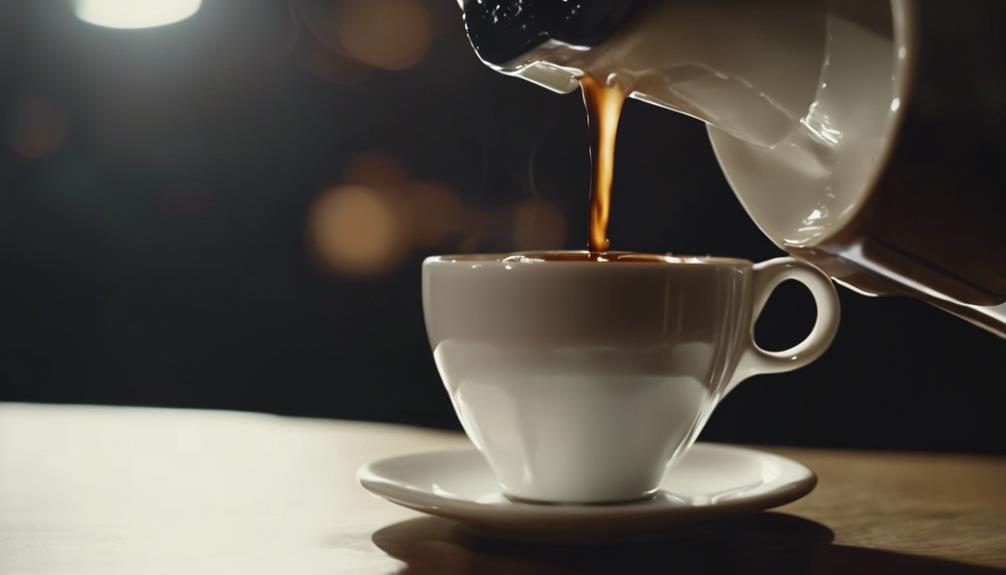
When water lingers too long with coffee grounds, it extracts excessive bitterness, affecting the flavor of your espresso.
Over-extraction occurs when the fine grind size or tightly packed grounds lead to prolonged brewing times, high water temperatures, and insufficient tamping pressure. These factors intensify the bitter taste in your espresso, disrupting the intended flavor profile.
To guarantee proper tamping pressure is around 30lbs and adjust variables like grind size, brewing time, and water temperature accordingly. Fine-tuning these elements allows you to control the extraction process, resulting in a balanced flavor profile without the overwhelming bitterness.
By mastering these techniques, you can enjoy a well-rounded espresso that highlights the intricate flavors of the coffee beans without being overshadowed by excessive bitterness.
Role of Water Temperature in Bitterness

Water temperature is a critical factor influencing the taste of your espresso. Incorrect temperatures can result in bitterness due to poor extraction.
Achieving the ideal temperature range of 195°F to 205°F is key to extracting flavors without the unpleasant bitterness.
Impact of Heat
Maintaining the ideal water temperature range of 195-205°F is essential in preventing bitterness and achieving a balanced extraction in espresso. When water is too hot, above 200°F, it can over-extract the coffee, resulting in a bitter taste that may not be pleasant.
This bitterness can be intensified when scalding hot water interacts with the coffee beans, causing them to release harsh compounds that contribute to the undesirable flavor. Proper water temperature control is vital to avoid bitterness in espresso.
The sweet spot for brewing espresso is around 195-205°F, ensuring that the extraction process is optimized without extracting too many bitter compounds from the coffee grounds. Consistent maintenance of water temperature throughout the brewing process is key to controlling bitterness and enhancing the overall flavor profile of your espresso.
Water Quality Effect
To further understand the impact of water quality on espresso bitterness, consider how different water compositions can influence the taste of your brew.
Water temperature is a critical factor in determining the bitterness of your espresso. Higher temperatures can often result in a more pronounced bitterness, while the ideal water temperature for brewing espresso falls within the range of 195-205°F to avoid excessive bitterness.
Using hard water, which contains high mineral content, can intensify bitterness in your espresso, altering the final taste of your shot.
Consistent water quality and temperature control are key to preventing unwanted bitterness in your espresso shots. Utilizing proper water filtration systems can help reduce mineral content and potential bitterness, ensuring a more balanced and enjoyable espresso experience.
Extraction Duration Influence
Achieving a balanced espresso taste relies heavily on the precise control of water temperature during the extraction process. Water temperature plays a critical role in influencing the extraction duration, impacting the flavors present in your espresso shot.
Higher water temperatures can expedite the extraction process, potentially leading to over-extraction and a bitter taste. Conversely, lower water temperatures may prolong extraction, resulting in under-extracted flavors that can bring sourness to your espresso.
To avoid bitterness and maintain the water temperature within the range of 195-205°F (90-96°C) is essential. Consistent monitoring and control of the water temperature throughout the brewing process are key in regulating the extraction duration.
Influence of Coffee Bean Quality

High-quality coffee beans play a pivotal role in determining the bitterness level of your espresso. When it comes to influencing the bitterness of your brew, factors such as the type of coffee beans, roast level, and freshness are important.
Consider the following:
- Type of Beans: Opt for specialty Arabica beans over Robusta beans to potentially reduce bitterness in your espresso.
- Roast Level: The degree of roasting can impact bitterness, with dark roasts intensifying it more than light or medium roasts.
- Sourcing and Freshness: Make sure you source fresh beans from reputable roasters. Freshness and sourcing directly affect the taste and bitterness of your espresso.
How to Avoid Bitter Espresso
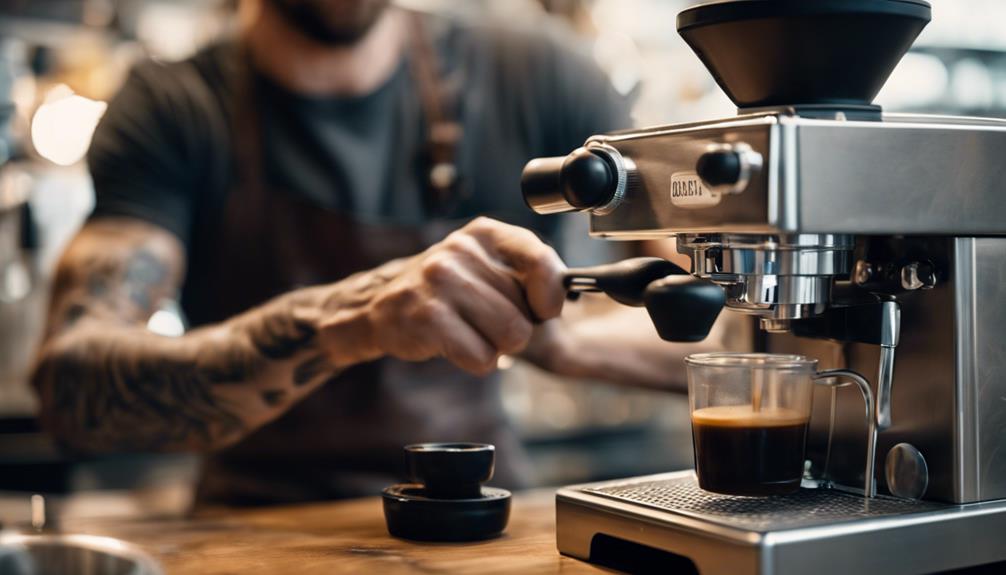
Adjusting the grind size of your coffee beans can help prevent over-extraction and the resulting bitterness in your espresso. When the grind is too fine, it can lead to over-extraction, extracting more bitter compounds from the coffee. Conversely, a coarse grind may result in under-extraction, leaving behind sour flavors.
Properly tamping the coffee grounds is essential for ensuring even extraction. Uneven tamping can cause water to flow through the grounds unequally, leading to a bitter taste in your espresso.
To further avoid bitterness in your espresso, use fresh, high-quality beans. Stale beans can produce a flat and bitter taste. Keep an eye on the water temperature as well; water that's too hot can extract undesirable bitter flavors.
Experiment with different brewing ratios to find the right balance between flavors and avoid bitterness. By paying attention to grind size, tamping, bean quality, water temperature, and brewing ratios, you can achieve a balanced and flavorful espresso shot.
Solutions for Bitter Espresso Taste

To reduce the bitter taste in your espresso, consider adjusting the grind size to be coarser for a smoother flavor profile. Additionally, using fresher coffee beans and maintaining proper storage conditions can help prevent bitterness in your espresso.
Checking and adjusting the water temperature is vital as it greatly impacts the taste of your espresso. Moreover, mastering the proper tamping technique, ensuring consistent pressure, is essential to avoid bitterness in your espresso shots.
Over-extraction, caused by prolonged brewing time, can also lead to a bitter taste in your espresso.
- Using fresher coffee beans can make a noticeable difference in the bitterness of your espresso.
- Adjusting the water temperature can be the key to achieving a balanced and less bitter espresso flavor.
- Perfecting your tamping technique is a skill that can greatly enhance the overall taste of your espresso.
Preventing Bitterness in Espresso Shots
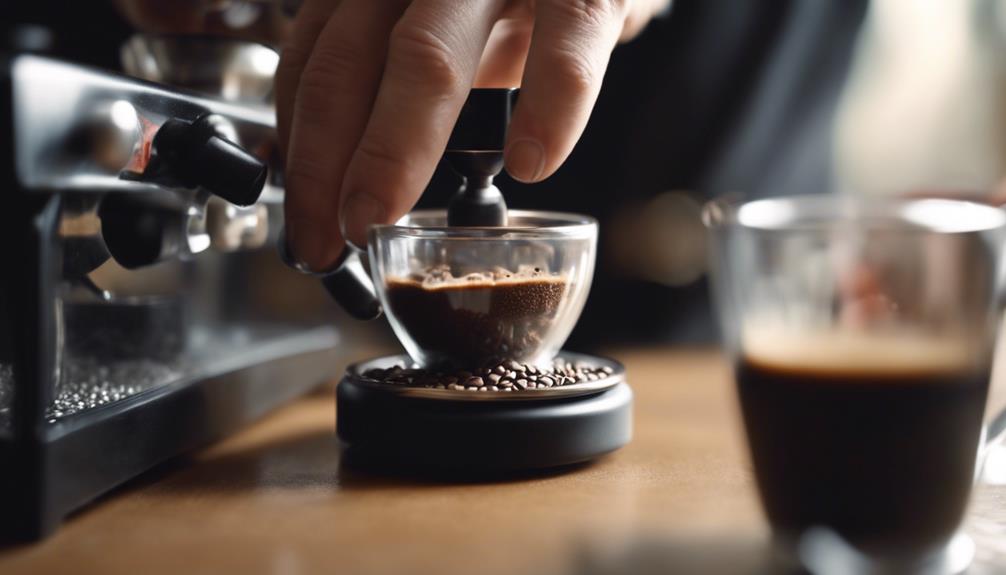
Prevent bitterness in your espresso shots by ensuring consistent tamping pressure and even distribution of coffee grounds. Inconsistent tamping pressure can lead to uneven extraction, resulting in a bitter taste. Additionally, over-extraction, where too many compounds are extracted from the coffee grounds, can contribute to bitterness. To avoid this, focus on using the right grind setting on your espresso grinder. Adjusting the grind setting helps achieve the best extraction level, preventing bitterness in your shots.
Using high-quality beans is essential in enhancing the flavor profile of your espresso and reducing bitterness. Fresh, high-quality beans can offer a smoother taste experience.
Furthermore, pay attention to water temperature and extraction time. Proper brewing parameters, such as maintaining the correct water temperature and controlling the extraction time, play a significant role in preventing bitterness.
Adjusting Brewing Parameters for Better Taste
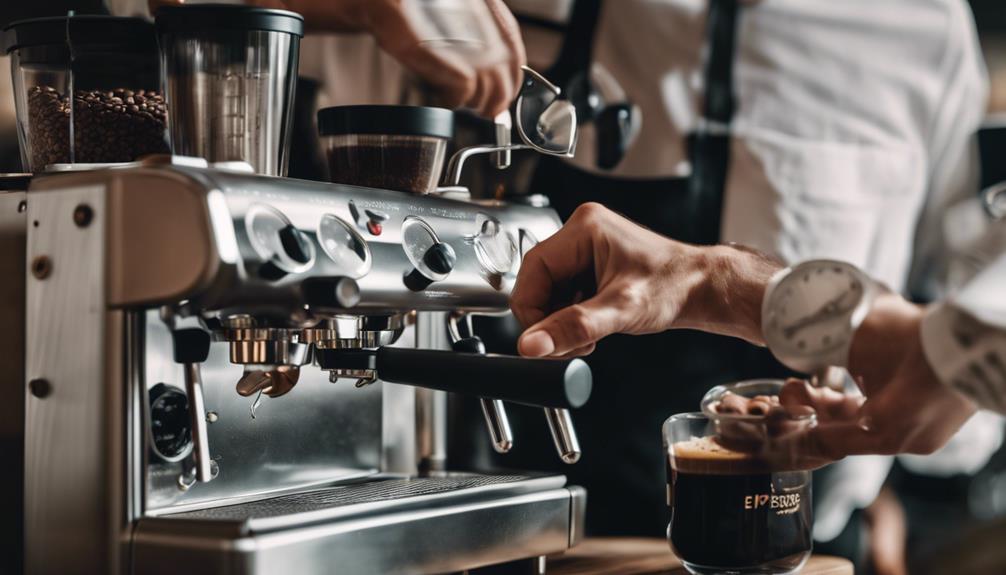
Achieving a better taste in your espresso involves fine-tuning brewing parameters to enhance flavor and minimize bitterness. To improve the taste of your espresso, consider the following adjustments:
- Adjust Your Grind: Experiment with different grind sizes to find the best one that balances extraction time and flavor. Finer grounds can lead to over-extraction, resulting in a bitter taste.
- Proper Tamping Technique: Make sure you tamp the coffee grounds evenly and with the right amount of pressure. Proper tamping helps in achieving consistent extraction, preventing bitterness in your espresso shots.
- Control Water Temperature: Monitor the water temperature closely as excessively high temperatures can lead to a burnt flavor. Adjusting the water temperature can have a significant impact on the overall taste of your espresso.
Enhancing Espresso Flavor Profile
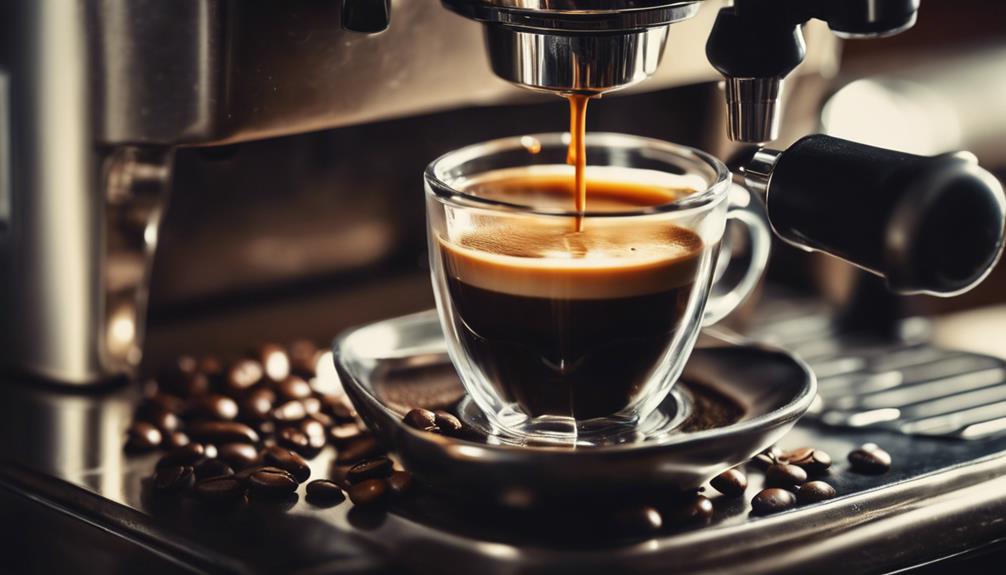
Enhancing the flavor profile of your espresso involves a delicate balance between extracting solids from the ground coffee and utilizing the right amount of water.
The bitterness in espresso can be affected by factors such as over-extraction, improper brew ratios, and the roast level of the beans.
To enhance the taste of your espresso, it's important to pay attention to the water amount used during brewing. Insufficient water can lead to a sour taste, while using too much water can result in bitterness.
Achieving the correct water amount through volumetric programming is key to balancing the flavors in your espresso shot.
Additionally, the grind size of the coffee beans plays a significant role in the extraction process and ultimately impacts the overall flavor profile of your espresso.
Frequently Asked Questions
Is Espresso Supposed to Taste Bitter?
Espresso isn't meant to taste overly bitter. It should offer a well-rounded flavor with hints of sweetness, acidity, and bitterness.
The bitterness in espresso comes from compounds like caffeine and tannins, adding complexity. To avoid excessive bitterness, use proper extraction methods like adjusting grind size, water temperature, and brew time.
Over-extraction, extracting too much from the grounds, can lead to a bitter flavor. Quality beans, fresh grinding, and precise brewing can help achieve a balanced espresso.
How to Make Espresso Taste Good?
To make espresso taste good, start by ensuring a proper extraction balance through adjusting grind size and tamping pressure.
Freshly roasted and ground coffee beans can enhance flavor. Control water temperature and brew ratio to prevent bitterness from over-extraction.
Regular equipment maintenance is key to avoiding rancid flavors. Experiment with different coffee beans and roast levels for a balanced taste.
Why Does My Espresso Have a Weird Aftertaste?
If your espresso has a weird aftertaste, various factors could be at play. Over-extraction, unclean equipment, or low-quality beans may contribute.
Inconsistent brewing parameters, like water temperature, can also affect taste. Consider water quality, bean storage, and ground freshness.
Address these variables to refine the flavor of your espresso and achieve a more satisfying taste experience.
How Do You Fix the Taste of Espresso?
To fix the taste of espresso, start by adjusting grinder settings for coarser grounds and ensuring proper tamping pressure around 30lbs. Aim for a shot time of 20-30 seconds to avoid bitterness. Different beans may require specific grinder settings for best extraction.
Prevent burnt flavors by avoiding overheating during brewing. By mastering these techniques, you can enhance the flavor profile of your espresso and enjoy a more balanced and enjoyable cup.
Can Decaf Espresso Still Taste Bitter?
Yes, even a decaf espresso can still taste bitter. While the process of removing caffeine from coffee beans can alter the flavor profile, the bitterness from the natural compounds in coffee still remains. So, a shaken espresso sans caffeine may still have that familiar bitter taste.
What Causes the Bitter Taste in Espresso?
Understanding bitter espresso flavors is essential for coffee enthusiasts. Several factors can contribute to the bitter taste in espresso, including over-extraction, burnt coffee grounds, or an improper brewing temperature. Achieving the perfect balance of flavors is crucial for a smooth and enjoyable espresso experience.
Conclusion
To sum up, bitter espresso can result from factors such as over-extraction, water temperature, and bean quality.
To avoid bitterness, adjust brewing parameters and focus on enhancing the flavor profile.
By paying attention to these key elements, you can enjoy a more balanced and satisfying espresso experience.
Remember, the perfect shot of espresso is a delicate balance of precision and quality ingredients.
Espresso
Breville Espresso Maker – Elevate Your Coffee Game at Home!
Create your perfect cup with the Breville Espresso Maker, a game-changing machine that brings coffee shop-quality drinks to your home.

You're about to take your home coffee game to the next level with the Breville Espresso Maker, a machine that's designed to deliver high-quality, coffee shop-style drinks with ease and convenience. With its quick access to perfect home beverages, you'll be able to brew single and double shots in no time. The machine's super quick technology and internal water tank make it ideal for busy days, and its flexible options cater to your individual preferences and hosting needs. As you explore the Breville Espresso Maker's features, you'll discover just how easy it is to create your perfect cup.
Key Takeaways
- The Breville Espresso Maker allows for quick and easy coffee preparation, ideal for busy days and tailored coffee experiences.
- With three-second activation and internal water tank, brewing is simplified and eliminates the need for external water sources.
- The machine offers precise control over froth levels and temperature settings for customized steaming results and perfect milk textures.
- Cleaning and maintenance are easy with quick clean-up, automatic milk expulsion, and simple surface wipe and rinsing.
Key Features and Benefits
When it comes to the Breville Bambino espresso maker, you'll find a range of key features and benefits that make it an ideal choice for coffee lovers.
Starting with its ability to brew both single and double shots of coffee, whether you're in the mood for a quick single shot or a richer double shot, this machine's got you covered.
This feature allows for great flexibility to tailor your coffee experience according to your daily cravings and moods. It caters perfectly for individuals and when hosting, letting you choose how intense your espresso shot needs to be, on-demand, just when you want.
It takes mere seconds for you to decide you're up for another caffeine dose.
The Breville Bambino ensures you can quickly access a perfect home beverage, making it a great companion for those busy days.
Thanks to its super quick technology features, you can enjoy your coffee without unnecessary delays, allowing you to make the most of your time.
This espresso maker supports your busy lifestyle, making it easier to enjoy quality coffee at home without sacrificing convenience.
Coffee Preparation Made Easy
With its impressive array of key features and benefits, the Breville Bambino espresso maker is designed to make coffee preparation a breeze, allowing you to focus on what really matters – enjoying your perfect cup of coffee.
You'll appreciate the three-second activation time, which enables immediate brewing with just the push of any button. This means you can quickly get started with your coffee preparation, whether you're using freshly ground coffee or pre-ground options.
The double shot cup guarantees a rich and robust flavor in every cup, and the internal water tank simplifies the brewing process by pulling water directly from the tank. This eliminates the need for external water sources, making the process even more streamlined.
You'll also appreciate the flexibility of the Breville Bambino, as it allows you to prepare coffee and milk in any order you prefer. With its user-friendly design, you'll find it easy to operate and maintain the machine, making the shift from coffee preparation to enjoying your beverage seamless.
Whether you're a coffee novice or connoisseur, the Breville Bambino makes it easy to prepare a perfect cup of coffee every time.
Mastering Milk Steaming Techniques

Achieving mastery over milk steaming techniques is a crucial step in elevating your coffee game, and the Breville Bambino is designed to help you get there with precision and ease.
With the Bambino, you can achieve precise control over froth levels, offering low, medium, or high options to tailor your drinks to your preference. This means you can create a perfectly balanced latte or cappuccino with freshly steamed milk every time.
The machine's three temperature settings – low, medium, and high – allow you to customize the steaming process for various beverages, guaranteeing perfect results every time. Utilizing heat sensor technology, the Bambino guarantees ideal foaming and steaming, making it easier to create café-quality drinks at home.
You can achieve a medium froth latte in approximately one minute and three seconds, allowing for quick preparation without sacrificing quality. With the Bambino, you can experiment with different milk types and flavors to create unique and delicious drinks that are freshly made to your liking.
Cleaning and Maintenance Tips
To keep your Breville Bambino in top working order, you'll want to make cleaning and maintenance a regular part of your routine. This guarantees your machine remains in prime condition, allowing you to enjoy perfect coffee at home every time.
Here are some quick cleaning and maintenance tips to keep in mind:
| Task | Description |
|---|---|
| Quick Clean-up | After each use, spend 20 seconds wiping down surfaces and rinsing components. |
| Automatic Milk Expulsion | The Breville Bambino automatically expels excess milk after steaming to prevent damage and maintain cleanliness. |
| Final Cleaning | Simply wipe surfaces and rinse components to keep your machine in top condition. |
Enhancing Your Home Coffee Experience
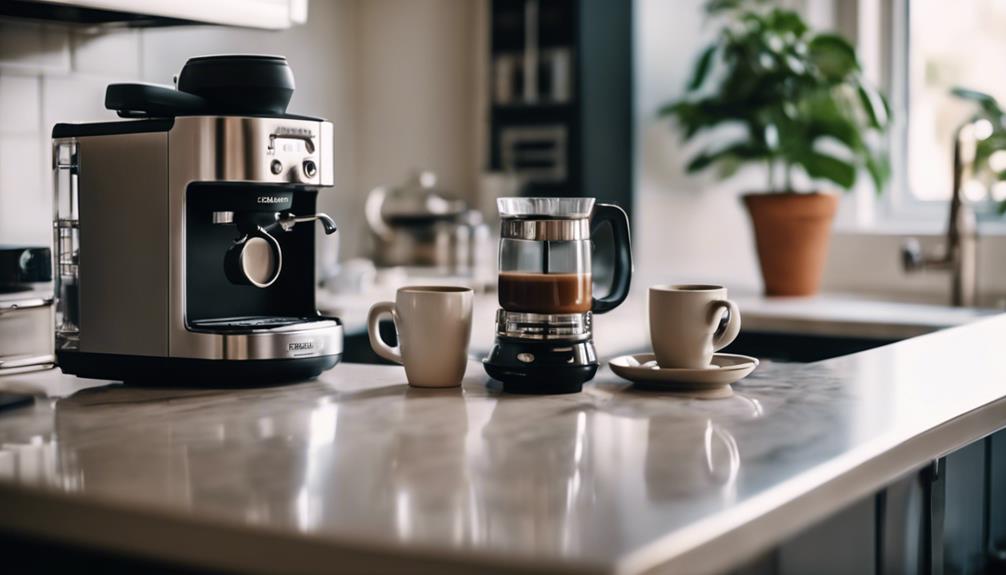
You're now the barista, bringing the coffee shop experience right into your own kitchen with the Breville Bambino's versatile capabilities.
With this machine, you can create a variety of coffee drinks that cater to your unique tastes. Whether you prefer a strong single shot or a rich double shot, the Breville Bambino has got you covered. You can use freshly ground coffee beans to make each shot, ensuring the best flavor possible.
The machine's quick setup and activation time of just three seconds mean you can enjoy your coffee without waiting around. Plus, with control over milk froth levels and temperature settings, you can customize your beverages to suit your taste.
Want a latte or cappuccino? No problem! The Breville Bambino makes it easy to create these popular coffee drinks at home. By using freshly frothed milk and expertly pulled shots, you'll be able to elevate your home coffee experience to new heights.
With the Breville Bambino, you'll be enjoying coffee shop-quality drinks in the comfort of your own home in no time.
Frequently Asked Questions
How to Make a Latte at Home With Breville Espresso Machine?
You're just a few steps away from a perfect latte! Start by brewing a double shot of espresso, then froth milk to your desired level using the steam wand, and combine for a beautiful layered effect.
Why Is Breville so Expensive?
You're likely wondering why Breville is pricey. It's due to the brand's focus on quality materials, innovative technology, and user-friendly features, which justify the higher cost for a premium coffee experience and long-term durability.
What Is the Best Grind Number for Breville Espresso?
You're seeking the perfect grind, balancing flavor and crema. Typically, a setting between 14 and 18 is ideal. You'll want to experiment, adjusting in small increments, to find your perfect shot, as you refine your espresso game.
Can You Put Ground Coffee in a Breville Espresso Machine Grinder?
You can't put ground coffee directly into the Breville Bambino's components, as it doesn't have a built-in grinder. Instead, you'll need to use a separate grinder to prepare the coffee before loading it into the machine.
Conclusion
You're now the maestro of your own coffee universe, with the Breville espresso maker as your trusted sidekick.
Just as a skilled artist weaves a masterpiece, you'll craft rich, velvety shots that awaken your senses.
As the aromatic espresso flows, imagine the morning sun bursting through your window, bathing your day in warmth and possibility.
Your coffee game has officially been elevated, and every sip is a reflection of your newfound mastery.
Espresso
What Is Espresso? Uncover the Secrets Behind This Bold Brew!
Behind the rich flavors and aromas of espresso lies a world of history, technique, and precision – discover its secrets.

You're about to discover the rich world of espresso, where a perfect blend of coffee beans, precise brewing techniques, and a dash of history come together to create a bold and complex brew. Espresso originated in 19th-century Italy, where innovators like Angelo Moriodo and Luigi Bezzera pioneered steam-driven coffee machines. To craft the perfect shot, you'll need high-quality beans, a balanced roast profile, and a fine grind size. With the right techniques and equipment, you can reveal the secrets of espresso and experience the vibrant flavors and aromas that make it a beloved morning ritual – and that's just the beginning.
Key Takeaways
- Espresso originated in 19th-century Italy, driven by increased coffee demand and the need for faster preparation.
- High-quality coffee beans, freshly roasted, yield rich flavor and aroma, with balanced roast profiles avoiding overly intense light roasts.
- The perfect brewing process involves optimal machine condition, fine grind size, consistent pressure, and peak extraction time of 25-30 seconds.
- Espresso brewing techniques require even tamping, ideal grind size, and proper extraction times for balanced flavor and improved extraction.
Origins of Espresso
When you explore the rich history of espresso, you'll find that it originated in 19th-century Italy as a response to the growing coffee demand and the need for faster coffee preparation in cafes. As coffee became an integral part of Italian culture, the need for a quicker brewing method became apparent.
Angelo Moriodo's invention of the first steam-driven coffee machine in 1884 marked the beginning of espresso's evolution. Luigi Bezzera improved upon Moriodo's design, using steam pressure to brew coffee, which laid the groundwork for modern espresso machines.
The term 'espresso' is derived from the Italian verb 'esprimere,' meaning 'to press out,' reflecting the method of extracting coffee rather than the speed of preparation. You might think that 'espresso' refers to the speed at which coffee is made, but it's actually about the process of forcing pressurized hot water through finely ground coffee.
Understanding the origins of espresso and its early innovators, like Moriodo and Bezzera, helps you appreciate the complexity of brewing coffee and the significance of Italy in shaping the world's coffee culture.
Delving into espresso's history can also help you refine your coffee palate and appreciation for the perfect cup.
The Perfect Brewing Process
To master the art of brewing espresso, you'll need to focus on several key elements that work together to create the perfect shot.
First, verify your espresso machine is in top condition, as it's the foundation of the brewing process.
Next, pay attention to the grind size of your coffee beans – a fine grind, similar to table salt, is ideal for even extraction and peak flavor.
When loading the portafilter, use 18-20 grams of coffee grounds for a single shot, which will result in a rich and concentrated brew.
Tamp the grounds with consistent pressure to promote balanced extraction and flavor.
Now, it's time to brew. The peak extraction time is between 25-30 seconds – too fast and the flavors will be weak, too slow and the shot will be bitter.
As you perfect the brewing process, you'll reveal the rich flavors that espresso has to offer.
With practice, you'll be able to coax out the unique characteristics of each coffee bean, creating a truly exceptional shot.
Ideal Coffee Bean Selection
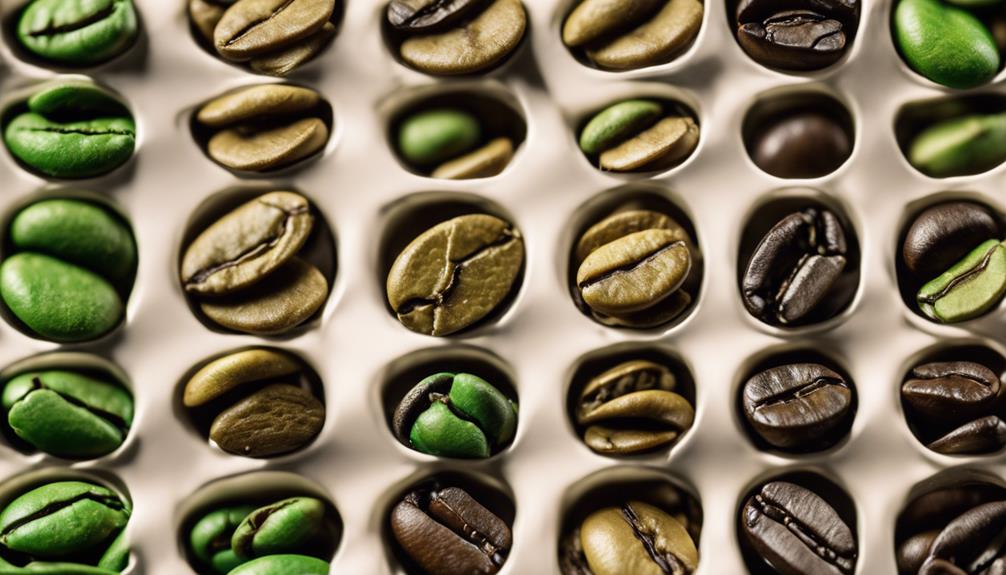
Selecting the right coffee beans is crucial for crafting exceptional espresso, and you'll want to focus on high-quality, freshly roasted beans that offer unique flavor profiles. When choosing beans, consider the roast profile and flavor profile you prefer. Here's a breakdown of key considerations:
| Bean Characteristics | Impact on Espresso |
|---|---|
| High-quality beans | Rich, vibrant flavor and aroma |
| Freshly roasted beans | Ideal flavor and aroma, with notes of fruit and chocolate |
| Balanced roast profile | Avoids overly intense light roasts, yielding a smooth, full-bodied espresso |
When selecting beans, you'll want to avoid those that are too light or too dark. Instead, opt for beans with a balanced roast profile that will yield a smooth, full-bodied espresso. High-quality beans are crucial for ideal flavor, and freshly roasted beans will guarantee the best possible taste. By choosing the right beans, you'll be well on your way to crafting exceptional espresso. Remember, the quality of the beans greatly influences espresso craftsmanship, so don't be afraid to experiment with different roast profiles and flavor profiles to find your perfect cup.
Espresso Roast Profile Explained
Now that you've selected the perfect coffee beans, it's time to explore the art of espresso roast profiles.
You'll want to understand the characteristics of espresso roasts, which are typically darker and roasted longer to bring out rich and bold flavors.
Espresso Roast Characteristics
When it comes to crafting the perfect espresso shot, understanding the nuances of espresso roast characteristics is key, as the roast profile plays a significant role in bringing out the desired flavors and aromas in your cup.
As you experiment with different espresso roast profiles, you'll discover that they often showcase a deeper, more caramelized flavor profile, thanks to the extended roasting time. However, keep in mind that achieving the perfect balance requires selecting the right type of coffee beans and fine-tuning your roast levels.
It's widely recognized that certain espresso beans – like lighter roasts – can yield overly intense flavors when brewed as espresso, resulting in a cup that's unbalanced and possibly bitter. Conversely, combining different coffee bean origins in the perfect proportion creates the magic blend you want.
That balance directly hinges on both beans you have to craft to effectively keep pace or resonate sound frequency. Yet, combining sound process procedures and putting the correct quantity can yield outstanding pure notes. This set blending produces the peak experience in your espresso.
Flavor Profile Balance
You're likely familiar with the concept that achieving a perfect balance in flavor profiles is vital for a great espresso experience, as it hinges on the delicate interplay between sweetness, acidity, and bitterness.
When it comes to espresso roast profiles, finding this balance is vital. Lighter roasts can be too intense if not roasted carefully, while darker roasts may become bitter if over-roasted. Adjusting roasting times and temperatures helps achieve the desired flavor balance, allowing for variations that cater to personal taste preferences.
To create a balanced espresso, roasters often blend different coffee grounds, including robusta beans, to enhance the caffeine content and introduce a fuller body. The ideal espresso roast profile should result in a harmonious combination of sweetness, acidity, and bitterness.
The presence of crema is a key indicator of the espresso's quality and flavor balance. By understanding how to balance flavor profiles, you'll be able to appreciate the nuances of different espresso roast profiles and find the perfect blend to suit your taste.
Whether you prefer a brighter, more acidic flavor or a richer, more robust taste, achieving flavor balance is vital for a great espresso experience.
Brewing Techniques and Tips
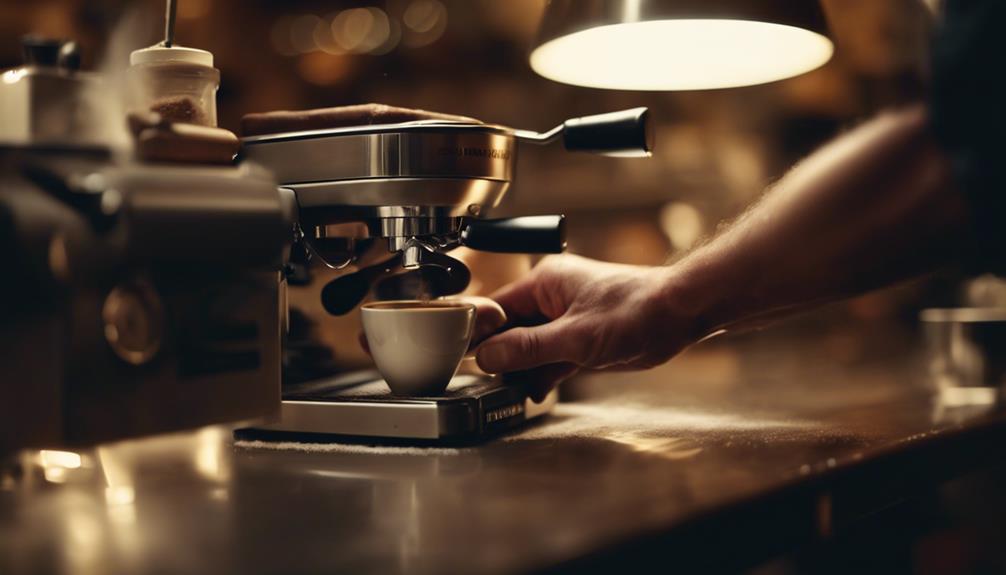
As you explore the world of espresso brewing, you'll quickly realize that perfecting the grind size is essential for achieving that perfect shot.
Mastering the grind size requires attention to detail and a bit of experimentation to find the ideal consistency.
Perfecting the Grind Size
To perfect the grind size for espresso, it's crucial to aim for a fine grind, similar to table salt, which is necessary for ideal extraction and rich flavor.
As you work to master the grind size, consider these key factors to optimize your brewing experience:
- Uniformity is key, and a burr grinder can help achieve the consistency needed for even extraction.
- A fine grind can enhance extraction but can also lead to bitterness if over-extracted.
- For a single shot of espresso, the ideal dose is between 18-20 grams of ground coffee, making precise measurements in grinding essential.
- Experimenting with different grind sizes affects the flavor profile; adjusting this is part of fine-tuning the espresso shot.
Keep these aspects in mind, and remember, fine-tuning your grind size with each use can guarantee your ground coffee complements your burr grinder for an unparalleled shot of espresso every time.
With consistent experimentation, you can enjoy that bold flavor everyone wants to know more about – every shot will deliver perfect and engaging outcomes in mastering that strong blend in brew form!
Mastering Brewing Techniques
Mastering brewing techniques is crucial for releasing the full flavor potential of your espresso, and it starts with understanding the importance of even tamping and precise water temperature control. When you tamp the coffee grounds evenly, you guarantee a balanced flavor profile and improved extraction quality. Additionally, monitoring the water temperature between 195-205°F during brewing is imperative, as this range greatly impacts the final taste of the espresso.
To achieve the perfect coffee, consider the following brewing techniques:
| Brewing Method | Water Temperature | Coffee-to-Water Ratio |
|---|---|---|
| Espresso | 195-205°F | 1:2 |
| Pour-over | 200-210°F | 1:15 |
| French press | 195-205°F | 1:12 |
When brewing espresso, use 18-20 grams of coffee grounds in the portafilter and aim for an extraction time of 25-30 seconds. This will prevent weak flavors from fast extractions or bitterness from slow extractions. By mastering these brewing techniques, you'll be able to bring out the unique flavors of your favorite beans and enjoy a perfect cup of coffee every time. With practice and patience, you'll become a skilled barista, capable of crafting exceptional espresso shots that impress even the most discerning coffee connoisseurs.
Fun Facts and Trivia
Discovering the lesser-known facts behind your favorite morning shot of espresso reveals a complex beverage that's full of surprising details, ranging from its etymology to brewing methods and misconceptions surrounding it.
As you sip on your espresso, you might be wondering what makes it so unique. Let's explore some fun facts and trivia that'll make you appreciate your daily cup even more.
Here are a few interesting tidbits about espresso:
- Espresso doesn't actually mean 'express' in Italian, but rather 'to press out' from the verb 'esprimere'.
- You might think espresso has more caffeine than filter coffee, but a standard serving of espresso actually contains less caffeine overall.
- Italian regulations require specific criteria for a shot of espresso to be considered true espresso, including minimum brewing pressure and extraction time.
- Historically, espresso blends often included robusta beans to increase caffeine content and enhance crema.
These facts show that there's more to espresso than just its bold flavors and rich aromas.
Whether you're a coffee connoisseur or just a casual fan, understanding the intricacies of espresso can enhance your appreciation for this beloved beverage.
Frequently Asked Questions
What Scientists Claim to Have Discovered the Secret to Perfect Espresso?
You're about to uncover the secret to perfect espresso! Scientists claim to have discovered that adding water before grinding coffee beans enhances consistency and taste, reducing static electricity and waste, and leading to stronger flavor extraction.
What Is Bold Espresso?
"Variety is the spice of life," and when it comes to bold espresso, you're in for a treat. You're brewing a concentrated coffee by forcing hot water through finely ground beans, resulting in a rich, strong flavor.
How Is Espresso Different From Coffee?
You're probably wondering how espresso differs from regular coffee. The main differences lie in brewing pressure, grind size, extraction time, and serving size, resulting in a richer, more intense flavor and a unique crema layer in espresso.
What Is the Difference Between Bold and Strong Coffee?
You might've noticed how some friends order "bold" coffee, while others ask for "strong" coffee. What's the difference? Think of it like music – bold coffee is like a rich, complex symphony, while strong coffee is more like a loud, intense beat.
Conclusion
As you wrap up your espresso journey, it's no coincidence that you've discovered the perfect blend of art and science.
The rich flavors and bold aromas have likely left you wondering how something so small can pack such a punch.
It's a coincidence that the same passion and dedication that goes into crafting each shot is the same passion that drives you to savor every last drop.
Espresso
How to Make the Perfect Espresso Martini – Step-by-Step Guide!
Learn the art of crafting the ultimate Espresso Martini with our expert guide, but be warned: once you taste perfection, there's no turning back.

To make the perfect Espresso Martini, you'll need 50ml of vodka, 35ml of coffee liqueur, and 25ml of freshly brewed espresso. Start by brewing a strong shot of espresso and letting it cool. Fill a cocktail shaker with ice, add the vodka, coffee liqueur, and a splash of simple syrup, and shake vigorously for 15 seconds. Double strain the mixture into a chilled martini glass and garnish with three coffee beans. With these basics down, you're ready to take your Espresso Martini to the next level – and with a few tweaks, you can make it truly unforgettable.
Key Takeaways
- Brew a strong shot of espresso and let it cool to maintain flavor in the martini.
- Fill a cocktail shaker with ice, adding vodka, coffee liqueur, and simple syrup for a balanced mix.
- Shake the mixture vigorously for 15 seconds to create a rich, frothy texture in the martini.
- Double strain the mixture into a chilled martini glass using a cocktail strainer and fine mesh sieve.
Ingredients and Equipment Needed
To craft the perfect Espresso Martini, you'll need to gather a few essential ingredients and pieces of equipment, starting with a trifecta of vodka, coffee liqueur, and freshly brewed espresso.
The vodka should be 50ml, while the coffee liqueur should be 35ml – Kahlúa is a popular choice. The espresso, which is the star of the show, should be 25ml and freshly brewed.
In terms of equipment, you'll need a cocktail shaker to mix everything together. A jigger will also come in handy for accurate measurement of the ingredients.
Additionally, a fine mesh sieve or cocktail strainer is necessary for a smooth pour into the martini glass. Don't forget the ice – you'll need fresh cubes to chill the cocktail without diluting it.
A pre-chilled martini glass is also a must, so make sure to fill it with ice before pouring in the Espresso Martini.
With these ingredients and equipment at your disposal, you'll be well on your way to creating the perfect Espresso Martini.
Step-by-Step Preparation Guide
With your ingredients and equipment at the ready, it's time to start crafting the perfect Espresso Martini by following a simple, step-by-step preparation guide.
Begin by brewing a strong shot of espresso and letting it cool to prevent dilution when mixed with ice.
Next, fill a cocktail shaker with ice, then add 1 1/2 oz. vodka, 1 oz. coffee liqueur (like Kahlúa), and 1/2 oz. simple syrup to balance the flavors.
Shake the mixture vigorously for about 15 seconds to create a frothy texture and guarantee everything is well combined. This step is essential in bringing out the rich flavors of the espresso and coffee liqueur.
After shaking, double strain the mixture into a chilled martini glass to achieve a smooth pour and eliminate any ice shards.
Finally, garnish with three coffee beans to symbolize health, wealth, and happiness, and serve immediately for the best experience.
Expert Tips for Success
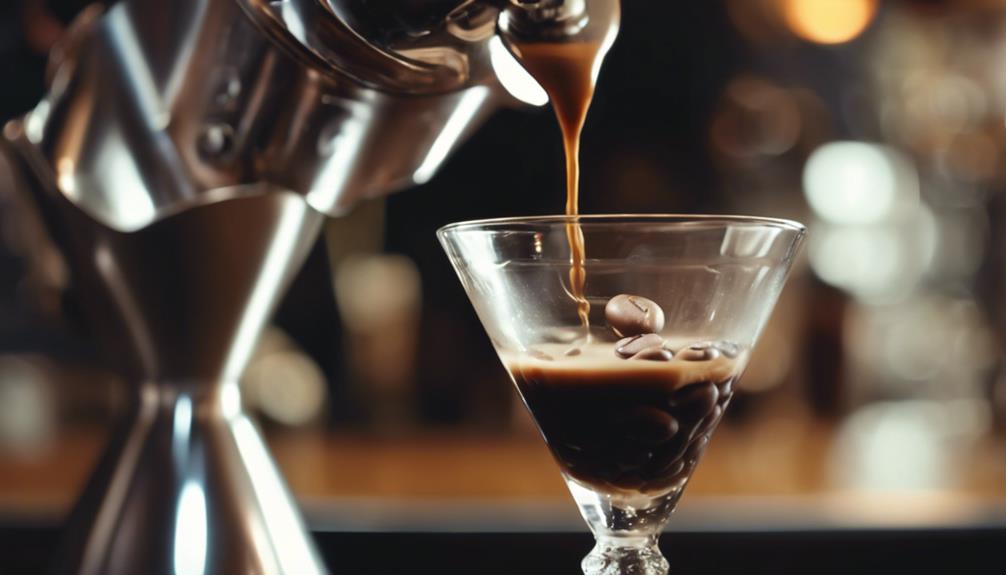
Mastering the art of crafting the perfect Espresso Martini requires attention to detail and a few expert tips to elevate your mixology skills.
To start, verify your espresso is freshly brewed and cooled to prevent dilution when mixed with ice in the cocktail shaker. This simple step will make a significant difference in the overall flavor and texture of your Espresso Martini.
When shaking the mixture, don't be shy – vigorously shake the cocktail shaker for at least 15 seconds to create a rich, frothy texture that enhances the drink's presentation and mouthfeel.
To achieve a smooth pour without ice shards, use a cocktail strainer along with a fine mesh sieve to double strain the mixture.
Experiment with different coffee liqueurs, such as Tia Maria or newer brands, to discover unique flavor profiles that suit your taste preferences.
Finally, adjust the amount of simple syrup to balance the bitterness of the espresso with the sweetness of the liqueur.
By following these expert tips, you'll be well on your way to crafting a perfect Espresso Martini that will impress even the most discerning palates.
With practice, you'll refine your skills and create a truly exceptional cocktail.
Understanding the Espresso Martini
You're about to explore the world of the Espresso Martini, a cocktail that's equal parts energizing and indulgent, and has been a staple of nightlife for decades. This classic drink has gained a massive following among coffee lovers and cocktail enthusiasts alike.
The Espresso Martini's unique blend of vodka, coffee liqueur, and freshly brewed espresso creates a flavor profile that's both rich and indulgent. The drink's origins date back to the 1980s, when British bartender Dick Bradsell created it in response to a request for a drink that would both awaken and intoxicate the drinker.
Traditionally garnished with three coffee beans, each bean symbolizes health, wealth, and happiness in Italian culture. The Espresso Martini's popularity soared in London's nightlife and has seen a resurgence in recent years. Its balance of bitter espresso and sweet coffee liqueur makes it a perfect choice for after dinner or special occasions.
As you explore into the world of the Espresso Martini, you'll discover why it's a timeless classic that continues to captivate palates around the world. With its unique flavor profile and energizing kick, it's no wonder the Espresso Martini remains a favorite among coffee lovers and cocktail enthusiasts.
Common Variations and Substitutions
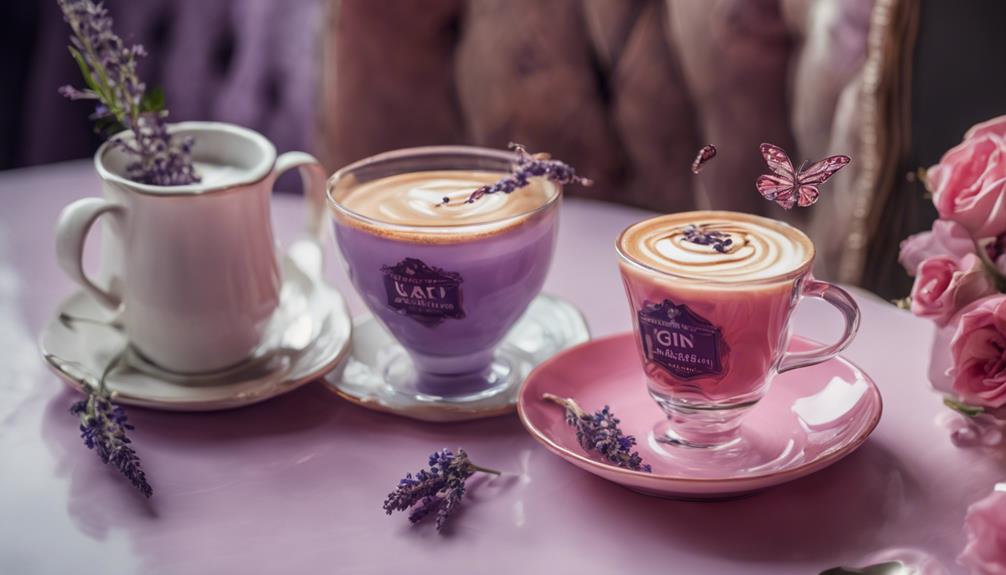
When it comes to perfecting the Espresso Martini, the door is wide open to creativity through substitutions and variations, allowing you to customize this iconic cocktail to suit your personal taste.
If you don't have an espresso machine, you can try using cold brew concentrate as a substitute for espresso, which provides a similar coffee flavor without the need for brewing.
In addition to espresso substitutes, you can also experiment with coffee liqueur alternatives to Kahlúa. Try using Tia Maria or a newer brand to offer a unique flavor profile to your martini.
If you're looking to make sweetness adjustments, you can modify or omit the simple syrup altogether. If you prefer a less sweet drink, consider reducing the amount or using flavored syrups like vanilla or hazelnut.
Serving Suggestions and Pairings
What makes the Espresso Martini truly shine is its versatility in pairing with a variety of sweet and savory treats, allowing you to elevate your entertaining game with ease. When it comes to pairings, you can't go wrong with rich desserts like chocolate mousse or tiramisu, which complement the drink's coffee notes perfectly. But that's not all – the Espresso Martini also makes a delightful after-dinner drink, helping to alleviate post-meal lethargy with its caffeine content.
| Occasion | Pairing Suggestions | Why it Works |
|---|---|---|
| Dinner Party | Dark chocolate or gourmet coffee-flavored treats | Elevates the tasting experience with sophisticated flavors |
| Birthday or New Year's Eve | Light appetizers like cheese platters or charcuterie boards | Balances savory and sweet elements for a festive atmosphere |
| After Dinner | Rich desserts like chocolate mousse or tiramisu | Complements the drink's coffee notes and alleviates post-meal lethargy |
| Casual Gathering | Coffee-flavored cookies or brownies | Enhances the drink's rich coffee flavor and adds a playful touch |
Frequently Asked Questions
What Are the Ingredients of an Espresso Martini?
You're looking for the ingredients of an Espresso Martini! Typically, you'll need 50ml of vodka, 35ml of coffee liqueur, and 1 shot of freshly brewed espresso, with optional simple syrup and Baileys for added flavor.
What Is the 3 Bean Rule for Espresso Martini?
You're about to discover the 3 bean rule, a traditional garnish for Espresso Martinis, symbolizing health, wealth, and happiness. This iconic presentation involves three coffee beans, typically arranged in a triangle pattern, on top of your drink.
What Are the Standards in an Espresso Martini?
"As you begin crafting an espresso martini, recall: "don't just aim to get close to perfect; instead aim beyond the possibility of 'very close.' Shoot to ace every corner on one precision push.'" Then define the actual definition without content contained context current webaddress–
What Liquor Is Best for an Espresso Martini?
When crafting an Espresso Martini, you'll want to choose a high-quality vodka that's smooth and flavorful. Opt for brands like Grey Goose or Belvedere, which won't overpower the other ingredients and will complement the coffee flavors nicely.
Conclusion
Now that you've mastered the art of crafting the perfect espresso martini, it's time to shake (not stir) things up!
With every sip, the rich flavors will transport you to a vibrant Italian night, where the air is electric and the music is pulsating.
Your taste buds will do the tango with the bold espresso, velvety vodka, and sweet coffee liqueur.
Cheers to a drink that's sure to perk up any gathering!
-

 Coffee Guides2 weeks ago
Coffee Guides2 weeks agoBoost Your Coffee: Easy Ways to Enhance Your Brew
-
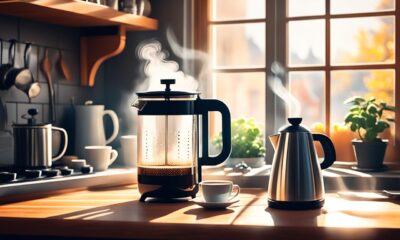
 Coffee Guides2 weeks ago
Coffee Guides2 weeks agoBrew Perfect Coffee at Home: Expert Tips & Tricks
-

 Health and Wellness2 weeks ago
Health and Wellness2 weeks agoHeadache-Free: How to Avoid Coffee Headaches!
-

 Vetted2 weeks ago
Vetted2 weeks ago15 Best Trundle Beds for Maximizing Space and Style in Your Home
-

 Coffee Guides2 weeks ago
Coffee Guides2 weeks agoBecome a Coffee Master: Expert Brewing Tips
-

 Coffee Guides2 weeks ago
Coffee Guides2 weeks agoBreve Coffee Explained: Your Cozy Café Favorite
-

 Coffee Guides2 weeks ago
Coffee Guides2 weeks agoHow to Be a Coffee Cup: Embrace Your Inner Brew
-

 Vetted2 weeks ago
Vetted2 weeks ago15 Best Cordless Pool Vacuums for Effortless Pool Cleaning
















